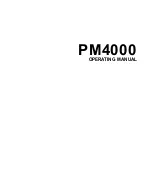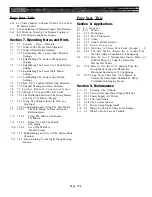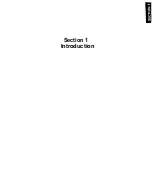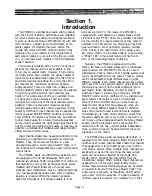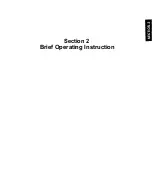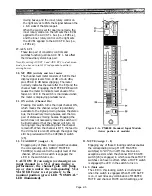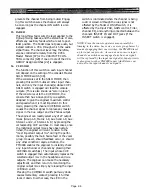
How to Use This Manual
If you are an engineer or technician who is familiar
with sound system design, much of this manual will
serve as a review for you. The basic features are
presented in the “BRIEF OPERATING INSTRUC-
TIONS” section. Check this and the “SPECIFICA-
TIONS” section, and you will see most of what you
need to know. The balance of this manual provides
background information for better utilization of the
console and auxiliary equipment.
If you would like to know more about AC power
distribution and safety, grounding, balanced versus
unbalanced cables, direct boxes, and so forth, this
information is also presented. Check the TABLE OF
CONTENTS.
There are internal preset switches within the
console which can be configured to change the func-
tions and/or signal paths in certain circuits. Refer to
the OPTIONAL FUNCTIONS section for details.
Terminology and
Typographic Conventions
Generally, where we refer to a particular control or
function as it is actually labeled on the console, we
will use all upper case type. That is, if we refer to an
input channel’s gain control, we may print “the input
GAIN control.” On the other hand, if the feature is not
labeled, we will use upper case type only on the first
letter; for example, “observe there is no identification
of the input Fader.” If the front panel label is incom-
plete or ambiguous, we may augment it. For example,
the input channel pushbutton switches labeled “1, 2,
3, 4, 5, 6, 7, 8” may be accompanied by the parenthetic
reference “(group bus assign)“.
Warning: To prevent fire or shock
hazard, do not expose this appliance
to rain or moisture.
There are eight groups (or subgroups, depending
on your linguistic preference). The group faders are
known as “Group Master Faders”. Their function is to
control the level on the eight “Group Mixing Busses.
The eight group busses are different and distinct from
the eight “Auxiliary Mixing Busses. The Stereo Fader
is actually a pair of closely spaced faders (L and R);
when we refer to the general function, we use the
term “Stereo Fader,” but if the availability of separate
left and right control is important, we may use the
plural “Stereo Faders.”
Particularly important information is distin-
guished in this manual by the following notations:
NOTE: A NOTE
provides key information to
make procedures or functions clearer or easier.
CAUTION: A CAUTION indicates
special procedures or guidelines
that must be observed to avoid dam-
age to the console or related equip-
ment, or to avoid an undesirable
result while using the console.
WARNING: A WARNING indicates
special procedures or guidelines
that must be observed to avoid in-
jury to the operator or others using
or exposed to the console or related
equipment.
In the BRIEF OPERATING INSTRUCTIONS
section of this manual, each feature is provided with a
numerical reference. Elsewhere, if we are referring to
that feature, we may cite the reference number in
square brackets for clarity. For example, on the input
module, the fourth control to be described is the PAN
pot. In other places on the console there are other
PAN pots. For clarity, then, if we are discussing this
particular input PAN pot, we will describe it like this:
"the PAN pot [2]". Now, here’s a real warning that
Underwriters Laboratories says we have to print:
Page A-1
Summary of Contents for PM4000
Page 1: ...PROFESSIONAL AUDIO MIXING CONSOLE PM4000 OPERATING MANUAL YAMAHA ...
Page 2: ...PM4000 OPERATING MANUAL ...
Page 7: ...Section 1 Introduction ...
Page 11: ...Section 2 Brief Operating Instruction ...
Page 47: ...Section 3 Specifications ...
Page 51: ...Dimensional Drawings PM4000 Console all versions Page 3 4 ...
Page 52: ...Page 3 5 ...
Page 53: ...Page 3 6 PM4000 Console Rear Profiles ...
Page 54: ...Module Block Diagrams See back of the manual for overall system block diagram Page 3 7 ...
Page 55: ...Page 3 8 ...
Page 56: ...Page 3 9 ...
Page 57: ...Page 3 10 ...
Page 58: ...Page 3 11 ...
Page 59: ...Page 3 12 ...
Page 60: ...Section 4 Installation Notes ...
Page 72: ...Figure 4 13 Cables For Use With Balanced Sources Page 4 12 ...
Page 79: ...SECTION 5 Gain Structure and Levels ...
Page 82: ...Figure 5 1 Dynamic Range and Headroom in Sound Systems Page 5 3 ...
Page 86: ...Section 6 Optional Functions ...
Page 106: ...Section 7 Operating Notes and Hints ...
Page 119: ...Section 8 Applications ...
Page 127: ...Section 9 Maintenance ...
Page 131: ......
Page 132: ...YAMAHA VN02300 ...


